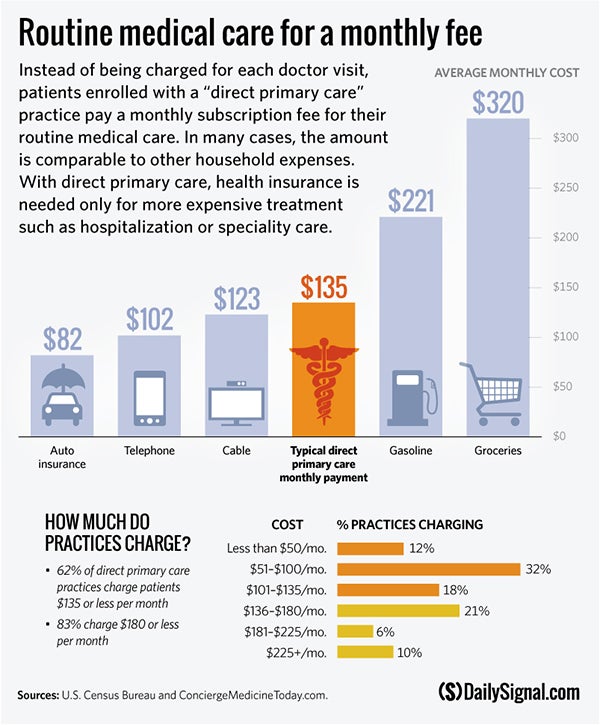“Direct primary care” is a rapidly growing alternative to the traditional “fee-for-service” model of paying for medical care. Instead of the patient or his insurance plan paying the doctor separately for each visit or service, the patient pays the physician a set monthly fee. In exchange, the physician is available to consult with and treat the patient as necessary.
>>> Direct Primary Care: An Innovative Alternative to Conventional Health Insurance
For patients, the benefits of direct primary care are greater access to their doctors and more convenient and personalized care. Under direct primary care, patients can generally expect “all primary care services covered, including care management and care coordination…seven-day-a-week, around the clock access to doctors, same-day appointments, office visits of at least 30 minutes, basic tests at no additional charge, and phone and email access to the physician.” Some practices may offer additional services under the arrangement, such as EKGs or medications at wholesale cost.
Physicians benefit from eliminating costly and time-consuming overhead required to get paid on a fee-for-service basis. It also enables them to reduce their practice costs and spend more time actually treating their patients–-which is why they became doctors in the first place.
More Affordable Than You Think
Direct primary care often comes with a reasonable price tag. Twelve percent of direct primary care practices charge less than $50 per person per month. One-third of practices charge $50 to $100 per month, and nearly two-thirds charge $135 or less per month. Those rates compare quite favorably to other common monthly consumer expenses. For instance, the average monthly cable bill is $123 a month, and, according to the U.S. Census Bureau, the average household spends $221 a month on gasoline and $320 a month on groceries.
But those numbers don’t tell the full story. Studies show that patients under direct primary care receive more focused preventive care, resulting in fewer costly hospital admissions, emergency room visits, specialist visits, and surgeries. By addressing health needs through better preventive care, most direct primary care patients save money that would have been spent on more expensive healthcare down the road.
Direct primary care is not a replacement for real insurance, and individuals enrolled in direct primary care should still have insurance to cover other medical costs, such as catastrophic care and specialist visits. However, directly paying for primary care eliminates the need for insurance to cover that portion of a patient’s medical expenses. Indeed, the sum of the direct primary care fees and the premium for a “wraparound” insurance plan—to cover costly treatments beyond the scope of primary care—can be substantially lower than the cost of a comprehensive insurance plan by itself.
By reducing both the administrative cost of providing primary care and the need for expensive specialty care, direct primary care can be affordable, and may even help save money.
More Personalized Care
Direct primary care appeals to physicians and patients alike. By dealing with patients directly, physicians benefit from increased autonomy, improved doctor-patient relationships, stable revenues, more time to focus on quality of care, and decreased time spent on coding, claims-processing, and negotiating with insurance companies. Direct primary care attracts many patients by providing better care and improved access at a lower cost. Individuals with chronic conditions (such as diabetes or hypertension) are particularly poised to benefit from the preventative aspects of this model.
The number of physicians practicing direct primary care has grown more than thirty-fold since 2005. As third-party payers continue to squeeze physician reimbursements and those difficulties are passed onto patients in the form of longer wait times and shorter, less attentive appointments, expect to see more patients and doctors turning to direct primary care as an alternative. Continued growth of direct primary care has the potential to provide some desperately needed consumer choice into a market which is largely homogenous. When patients have the option of accessible quality care at a practical cost, everyone wins.


























